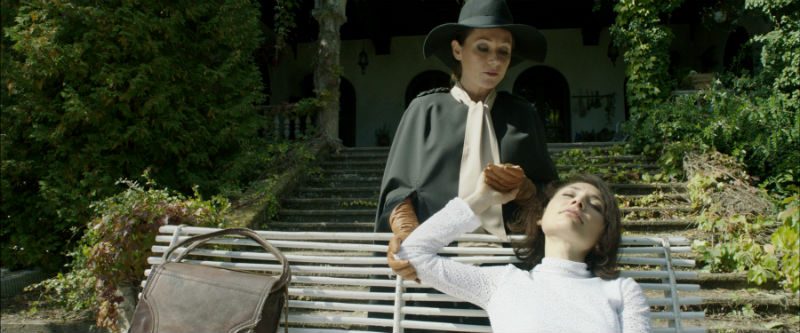The Duke of Burgundy is an erotic thriller has mixed appeal for lesbians.
There is no duke and it isn’t set in Burgundy, but somehow the title of this delicious red herring of a film, written and directed by Peter Strickland, is fitting. The Duke of Burgundy is about role-playing; it is set somewhere in Europe (although where is never specified); and it seems vaguely set in the past—although that could be because of the very retro mid-‘60s-‘70s production design. But here’s the question you really want answered: Is this a lesbian film? The answer: It is and it isn’t.
This low budget feature has enough sumptuous art direction and clever cinematic touches to make it a solid movie of the art house variety. The camera is beautifully positioned in every shot. The soundtrack is mesmerizing and hypnotic.
The screenplay is taught, teasing, and suspenseful, with sparing dialogue that avoids the ubiquitous lesbian filmmaking habit of over-emoting and thrashing the subtext to death. Plus, unlike many lesbian offerings that recycle stereotypes (hip heartbreakers Alex Vause, Shane, et al), the characters in The Duke of Burgundy are original—in this case, an entomologist domme and her submissive, blissfully domiciled in an ancient and opulent villa, conducting their sadomasochistic routines, and occasionally venturing out to give lectures on moths (one of which is called The Duke of Burgundy).
But all is not as blissful as it seems: Mistress of the house Cynthia (Sidse Babett Knudsen), with her high heels, stockings, pencil skirt and auburn wig complete with a French twist is a knockout, but it’s tiring being a top, day in, day out, and the repetition of ritual is exhausting her. Her “maid,” Evelyn (Chiara D’Anna), a schoolgirlish figure with her cape and bicycle, is a submissive, dutifully scrubbing floors, sweeping leaves, and polishing boots.
But we soon learn that her visits are scripted and that she’s Evelyn’s live-in lover. We also learn that she is a power bottom and she has all the power. Increasingly, Evelyn needs more and more masochist stimulation—panty washing and golden showers are okay, but being locked in a chastity chest would really get her off. Meanwhile, Cynthia, who feels she is aging, begins to yearn for a more conventional and gentler dynamic. You don’t have to be into BDSM to recognize this as a familiar problem with long-term couples, growing apart as their desires change over time.
Writer-director Strickland is a man, and interestingly the world he creates here is single sex: it took me a while to realize that there are no men in this film at all—not even as extras.
When “The Carpenter” arrives to discuss building Evelyn a bed with a chastity compartment it’s a cosmopolitan blonde bombshell with a very long tape measure! Wondrously, the male sex has been banished entirely from the mise-en-scene.
What this does to the idea of the “male gaze” is up to you, although in a scene at “The Institute” where women attend lectures about the mating call and markings of moths, the camera slowly pans to reveal two mannequins placed in the audience.
What is their purpose? Are these women dummies? Are we?
Strickland likes a little grand guignol, and there are a few other schlocky visuals: moody framing through windows and mirrors, bubbles popping in a tub of soaking panties, a corpse in a chest, moths mounted, moths flying through the night, grubs squirming in the earth, close-ups of a cat’s dilated pupils.
I’m not going to be a pussy about it: movies are about looking, about montages, and the medium makes us all voyeurs.
Strickland lavishes his attention, and ours, on his female subjects. In this way, he takes his cue from European auteurs such as Claude Chabrol and Luis Bunuel, whose female characters are feminine but powerful, mysterious, and on a quest to find out what makes them tick erotically.
But is The Duke of Burgundy really a lesbian film? Well, it actually passes the Bechdel Test with flying colors (it has at least two women characters; who talk to each other; about something other than a man). But in the end this is a film written and directed by a male filmmaker who knows more about cinema (and Strickland knows a lot) than he does about lesbians.
These lesbians are creatures of celluloid. Which is not to say that glamorous lesbian SM couples don’t exist. But Cynthia and Evelyn exist to be looked at by the camera, and by us. To be symbols that raise questions about the limits of desire. They’re not crazy, and they don’t die in the end, which makes this an easier film to watch than Black Swan or Les Diaboliques. But Loving Annabelle or Claire of the Moon this ain’t.
